Tuross Head is a picturesque seaside location, a short 5-10 minute drive off the Princes Highway between Moruya and Narooma on NSW’s beautiful South Coast. The township is nestled between two large scenic lakes and while it has a small resident population of around 2200 people, it’s a popular holiday home destination for Canberra locals as well as a favoured holiday destination for anglers and their families from much further afield.
Despite the holiday influx, Tuross’s growth is limited by geographical boundaries. With the ocean to the east, the lakes to the north and south, and highway to the west, there is very limited scope for new development or indeed over-crowding from holiday-makers.
There is a vast array of options for anglers, with great beach, rock and magnificent estuary fishing. Offshore anglers don’t have too far to travel to Narooma to launch for great fishing grounds offshore including Montague Island.
Tuross Lake is a beneficiary of the NSW Government’s wise decision in 2001 to buy-out commercial fishing licenses in a number of coastal estuaries. Unfortunately the buy-outs didn’t extend to Coila Lake, and consequently one of the great bream fisheries in the state, is sadly netted by a small few. Despite this, Tuross is still one of the best all-round fishing locations in the state - let’s look at what you can catch, where and how.
There are three beaches with good fishing in the immediate area, Blackfellows, Coila and Binji. Many great fishing beaches can also be found north and south for the adventurous as well – just grab a CMA Topographic map of Bodalla (8925-4-N) (which can be purchased online) to find how and where to access these beaches via dirt tracks.
The catchment of Coila Lake is relatively small; therefore the lake is only open to the ocean intermittently and usually for short periods. When Coila is closed there is easy access to a steeply shelving beach to the north of the Tuross township. Often there is a deep hole directly out from fthe entrance to the lake. This occurs as water from the closed lake seeps under the sand, weakening it at the entrance, which enables the sand to be pounded out by prevailing sea conditions.
This is a great spot for salmon most of the year. You will also score the occasional tailor although salmon dominate catches. Tailor fishing on the NSW South Coast peaks around December to April as the fish make their annual migration up the coast to spawning grounds such as Fraser Island. Dawn and dusk through to the night are best for salmon and tailor here and I have caught some big tailor to 66cm from this location during crisp autumn nights.
Every few years, including September 2015, Coila Lake is opened up to the sea by heavy machinery. This occurs when the lake reaches a level that is deemed to be a flooding risk from any further heavy rain or catchment inflows. When the lake opens, the fishing at the entrance can be spectacular for a couple of days as fish and prawns escape from the lake to the sea. If you are lucky you might also tangle with predators including mulloway that sit at the lake mouth to take advantage of the smorgasbord. The flush also offers the chance for renewal in the lake with the rising tides bringing fish and prawn larvae back into the system.
While Australian salmon tends to be rated quite low as a table fish, for those like me who love the fight and acrobatics of this species, nearby Binji Beach is the place for you. Binji is located a couple of kilometres north of Tuross, and those who are fit enough, with some time available can walk there when the lake is closed. Otherwise it’s a short drive back to the highway and then 5 minutes past Coila, take a turn to the right, where you can then follow a local map or GPS to end up on Binji Road. Take a dirt track to the right to come out just south of the rocks at the northern end of Binji Beach.
The salmon are known to congregate here at the northern end of the beach. The beach shelves away quickly and you can usually find some deep gutters within an easy cast from the shore. As it’s fairly exposed to the southerly swells, paternoster rigs with size 3-4 star sinkers are a better option than casting and retrieving running ball sinker rigs.
I’ve had a lot of fun here with catches of big 3kg+ salmon on offer. If you haven’t tried it, use paternoster rigs with 2-3 droppers, and a combination of a pilchard on gang hooks as well as surf flies and/or surf poppers on two other droppers. This requires a strong fluorocarbon leader of around 50lb and about 1m in length. The star sinker is attached to the bottom via a snap swivel so you can change sinker sizes easily, with 3 droppers of around 10cm in length. Just hold on when you get a couple of those 3kg salmon jumping and zigzagging in different directions! You will also catch the odd tailor and bream at Binji, but salmon will dominate catches.
While the entrance to Tuross Lake can be fished from the northern or Tuross side, the run-through here is quite strong and can make fishing difficult in all but around the change of tides. A better option is to jump in a boat and pull up on the back of the beach on the southern side of the lake entrance. If you don’t have a boat drive 30 minutes around to the southern side where you will eventually end up on a dirt track to Beachcombers Caravan Park. Here you can park and walk the 2-3km to the entrance, and maybe stop and fish prospective gutters along the way.
There are good beach worms and pipis along this beach for bait, and these juicy little morsels will catch you some big whiting, thumper bream and the occasional flathead at the entrance. You can also bring a yabbie pump and pump some nippers at the edge of the lake behind the beach as nippers fish very well around the entrance for the same fish. I’ve also caught the occasional luderick from the entrance on nippers, but this is the exception rather than the rule. Peak times for summer species such as whiting and flathead is around December to early April when the warmer currents arrive.
Along the last kilometre or so of the beach (from the rocks about halfway along) you can usually find a good gutter or two for tailor and salmon. For those that prefer tailor over salmon, this beach is a better option than further north at Coila and Binji. The occasional mulloway is also caught towards the entrance, and as usual these are best targeted with heavier gear and either a bunch of beach worms, a live legal tailor or fresh tailor fillet.
Rock fishing no longer has the popularity it once did in the 1970s and 80s possibly due to greater media attention that unfortunate rock fishing deaths generate in this age of social media. If you do fish the rocks you need to take great care and follow all the recommended guidelines and consider safety precautions like fishing in a lightweight lifejacket.
Assuming you do, there are a few good rock fishing locations nearby such as One-Tree Point at Tuross, Binji-Binji Point, Blackfellows Point and Potato Point headlands (the latter three require a 20-25 minute drive to the north and south respectively). A variety of species are available such as tailor, salmon, bream, drummer and blackfish in season.
A great technique to employ in these locations is to cast and retrieve a very lightly weighted pilchard on a gang hook at dawn and dusk (I prefer dawn to give me more light as the session progresses). This involves a very simple rig with a small size 1 ball or bean sinker running down to the hook. Cast out towards the wash in front of the rocks or in the wash behind other rocks in front of your fishing platform. Slowly retrieve the rig, making sure you speed it up as you get closer to the rocks as there is thick kelp growing directly in front of some of these rock platforms that just loves to eat lures and fishing rigs!
In light-medium swell, these rocks are also great spots for some fantastic fun throwing lures including poppers off the rocks. To see a couple of marauding tailor, or a 2kg+ hungry salmon chase and smack your popper in full view on the surface, sometimes a metre or two off the rocks, is exhilarating stuff and one of the reasons I love our great sport!
Another option off these rocks is to use a 1/0 suicide hook and striped tuna cubes for bait to chase bream. Berley close to rocks with a bucket mix of sand, water, unprocessed bran and tuna oil. Throw a couple of handfuls out at a time. Alternatively, tie a tuna frame to the rocks and let it disperse bits of berley as it washes around in the wash.
Unfortunately Coila Lake is still open to commercial fishing and it seems to cop a lot of commercial fishing pressure. As a result it is probably best to check with the locals at the tackle shop, or Scott Mazz the local fishing guide, on how it is fishing at the time.
The lake can at times produce some monstrous black bream, tailor, whiting, a few flathead and in years gone-by legal snapper in the deep hole on the northern side. As a result of the lake’s closure for the last few years, a thick weed has grown along the shoreline, which has made fishing from the shore really difficult.
Tuross Lake is the jewel in the crown of Tuross Head. Due to the lack of commercial netting for over a decade, the estuary fishing can be superb. As a result, flathead numbers and sizes have flourished, as have other species like whiting, bream, luderick, estuary perch, tailor and the mighty mulloway. The lake is made up of the main lake, the Tuross River and smaller lakes and creeks that offer a choice of locations to fish and explore.
There are two main public boat ramps in Tuross Lake. The most popular ramp at Lavender Bay is not far from the river mouth, while the second is on the northwest side of the bridge on the Princes Highway 6km south of the Tuross Head turnoff. The former is the most popular ramp for access to the front of the lake system. The latter is normally used for chasing fish upstream, particularly after a lengthy dry spell that has the effect of increasing the salinity levels of the Tuross River upstream. Anglers chasing estuary perch and bass also tend to launch from here.
There is also a third smaller dirt ramp for small boats and kayaks at the back of Horse Island. This ramp is accessed from the road to Potato Point where you then turn left to Horse Island Road. There is only really room for one or two cars/trailers here though.
While Tuross has been pro-free for over a decade, don’t turn up and expect the fish to simply jump onto your hooks. You still need to fish to the prevailing conditions, which are subject to both natural and human influences.
Natural influences can include the water temperature, water colour and salinity (due to recent rains or lack thereof), tidal influence (based on the flow at the entrance), cloud cover, and wind. Human influences can include boat traffic, boat noise and vibrations or recent fishing pressure in the location.
One way to adapt to the conditions is during the ‘in between’ seasons of spring and autumn. Use your sounder to find patches of warmer water, and you will soon find the fish. Sometimes you can find variances of 2-3°C in water temperature. Often the warmer water will be around the shallower areas of the lake, particularly those with dark mud or dark sandy bottoms further upstream from the entrance, which tend to retain the heat from the sun just like a dark t-shirt retains heat in summer.
Also, if there has been quite a bit of recent rain, the fish will move towards the entrance or sit in the cleaner salt water in the deeper holes. The cleaner water will be at the bottom of the deep holes as freshwater is less dense that salt water and hence will float on top of the salt water. In Tuross there are a couple of deeper holes you can target, in the main basin in front of the boatshed, and northeast of Reedy Island.
A great place to start before tackling any new location is to use Google Earth or grab a fishing and boating map of the area. NSW Roads and Marine have a handy waterproof map of Tuross and other nearby lakes available for purchase online for $7. Just look for map 13A - Moruya River Area and Congo Creek, Tuross, Coila and Mummuga Lakes. You can also download the Chartered Waters – Australia Fishing Maps app and get hold of a map of Tuross Lake on SD card or download an interactive map of the lake that includes contours, boat launching facilities, islands, campgrounds and navigation aids. The map displays shallow water (at normal water levels) and deep water, all colour coded for ease of use. Failing that, the Tuross Boatshed and Café has a rough mud map with a few suggested fishing locations on it.
As mentioned earlier, the fact Tuross has been free of commercial fishing for over a decade has significantly increased fish stock and sizes. The lake has consequently been building its reputation for some monster flathead. Of course anglers are encouraged to release the larger big breeders, particularly over 70cm.
The flathead fishing in Tuross is one of the reasons anglers return year after year. Take your choice, you can drift with whitebait or live poddy mullet, throw soft plastics or vibes, or troll hardbodies or soft plastics in the shallows. In fact, some of the big shallow bays in Tuross are perfect spots for the very underused technique of trolling plastics. Run two lines behind the boat on light jigheads of around 1/8 - 1/6oz, with a 2.5m fluorocarbon trace of around 8-14lb, depending on water colour (clearer line = lighter trace). I’ve also found if the water is discoloured even in shallow water of 3ft or so, you can get away with running the plastics as short as 8-10m from the boat. Be sure to also hold your rod and impart some action with it. If I’m driving the boat I will hold the rod over my shoulder and give the rod four or five gentle jerks from the horizontal to 90°C above my shoulder and slowly drop the lures back again keeping the line tight.
As usual, target locations are the edge of weed banks, edge of rocky outcrops, drain entrances and drop-offs and these are littered throughout Tuross. In fact, the fishing can be so good it’s important you limit your catch when the fish are on. A great way to look for the drop-offs is with quality sunglasses. Alternatively, look for the ripple effect on the water as the tide is falling. At one such location on the flats near the entrance in January last year, my 11 year old son threw seven casts for seven consecutive flathead (many released) simply by landing the bait and then a lure just past the ripple water of the drop-off onto the flats and slowly working it a few metres over the drop-off before bang, on again!
Top spots for flatties in the lake are nearly too numerous to list but include the flats behind the entrance, near the channel markers out from the boat ramp, the flats east of horse island, the four wayside and some of the shallow lakes such as Borang, even in the cooler months.
Luderick are also in good numbers in the lake, with fish caught throughout much of the year. Look for locations with a rocky deep shoreline, the edges of thick weed or submerged obstacles with weed growth. Places to try include the pipeline past the boatshed, the four ways and Sandy Point (just south of the boatshed). I’ve caught Luderick at the latter location on plastics, in particular using the 3” Gulp Swimming Mullet in watermelon.
Big whiting are also available from Tuross. Top spots include in front of the boat ramp (where you can wade out to the markers if you wish), on the flats behind the beach on the southern side, the flats up around Reedy Island and in the channel leading to the lake entrance (particularly at night).
Surface fishing for whiting has also grown in popularity at Tuross in recent years, largely as a result of the early success of anglers such as Kevin Gleed and Steve Starling. Much has been written about this topic in recent years including from Starlo himself and is definitely worth reading up on. Scott Mazz can also help beginners and those wanting to improve as well. The key is to keep your lure moving and not stop the retrieve. Walk-the-dog style lures require a side-to-side flicking action that can be achieved by keeping your graphite rod low to the water and tapping your rod with your finger while you retrieve. For poppers you want a slow constant wind with short, sharp stabs of the rod-tip to get the lure to ‘bloop’ or throw up water on the surface.
In terms of tackle, a good starting point for chasing whiting on the surface is to use ultra thin Suffix Nanobraid in 4lb, with a leader of around 2-2.5m of Sunline system shock leader in 4lb. This leader is a better option than fluorocarbon, which tends to sink and tends to pull the surface lure under the water. Productive walk-the-dog style lures include the Bassday Sugapen – replace the trebles with Ecogear ZX stinger hooks for better hook up rates. Surface poppers are probably your next best option with the Pop50 Atomic Hards also a productive lure for whiting on the surface.
Bream can be found in good numbers in the lake, particularly around the oyster leases up near the broadwater. They can also be found in the fallen trees and rocky outcrops in the smaller creeks and upstream of the highway bridge. Around February-April, the entrance to the lake is a top spot for some big specimens.
Mulloway are also on offer in the deeper holes in the lake, such as in the main basin in front of the boatshed. Ideally is you have a good quality downscan and sidescan sounder you can search around in the holes looking for baitfish and signs of bigger fish among them. Live baits and big soft plastics are the go. Fish to 13kg have been landed in the lake late in 2015.
As mentioned, bass and estuary perch are also available upstream from the Tuross Bridge. The lake and river are also home to garfish, trevally, flounder and mullet.
For those anglers wanting to target fish on bait off the beach and in the estuaries around Tuross, there are many places to catch your own live or fresh bait.
For those with a boat, there are plenty of locations to pump yabbies around the low tide in Tuross Lake. Just pull your boat up onto a sand bank behind Blackfellows Beach on the southern side or onto the sandbanks around some of the islands, such as Reedy or Horse Island.
A productive option at these spots is to pump yabbies in knee-deep water using a sieve and fish the berley trail while you yabby. You can either throw a line or two out for the kids, set your own rod, or use Polaroid sunglasses to pick out big whiting and toss out an unweighted yabby. I use Spotters photochromic lens sunglasses as these allow you to spot fish or melon holes even in cloudy conditions as they adapt to the light. I have been incredibly impressed with what these glasses allow me to see.
For those without a boat, there are a couple of spots with limited numbers of yabbies near the Tuross boat ramp and on the small sandy beaches right up near Tuross Lakeside Tourist Park. Otherwise a better bet might be taking a drive north to Moruya and pumping them from the Moruya river flats at low tide.
A few beachworms are available from the main beach at Tuross and on some of the small beaches between the rocky outcrops in front of the township. Otherwise, if you decide to fish the beach to the south of the lake then there are plenty of worms along there. The best worming is probably down the southern end, closer to the rocks near the Beachcomber Caravan Park.
A few tubeworms are also available in the darker black sandbanks behind the southern entrance of Tuross Lake. These are deadly bait for whiting around the entrance area. Better quantities of tubeworms are available further upstream in the Tuross River around some of the sandy islands.
Poddy mullet are an awesome bait for big flathead in the river. These can be caught using either a cheap mesh trap or clear plastic poddy mullet trap. While stale bread is a good option in and around the traps, the number one ‘bait’ for poddy traps in my view are hot potato chips! Their oily texture creates a great berley trail and even more so if you squish a couple as added berley around the trap.
One other piece of advice is to stir the bottom a little around the trap with your feet. I think this gives them a bit of protection and thus they are a little less hesitant to enter the trap. I came across this by accident when I slipped rear-end up once in the mud around the trap to the great amusement of my mates. The laughter turned to awe when I returned 10 minutes later to a trap full of poddy mullet! I’ve stirred the bottom up ever since.
If you can bring yourself to not eat them, live prawns, caught from the lakes at night are dynamite bait. They can be cast unweighted in among the fallen trees further up Tuross River or in many of the smaller offshoot creeks in the lake system. They are also deadly on big whiting particularly under the cover of darkness on the estuary flats at high tide or the channels near the entrance at low tide.
Green weed is your bait of choice for luderick in Tuross. Check with the guys at the boatshed as to where you might be able to access some fresh green weed locally.
Tuross and Coila lakes are popular spots for prawning around the new moon periods over late spring and summer. The best prawning in Tuross Lake is behind the beach on the southern side, particularly on a falling tide around the flats and edges of the channels. Coila Lake is generally a better prawning location, particularly if the lake has opened then closed again prior to summer. Coila is home to the greentail (or greasyback) prawn, which can complete its lifecycle in enclosed waters, however prawn stocks are noticeably improved if the lake is open to the sea in late winter.
Coila Lake had closed up again at the time of writing, so the prawning season in Coila should in theory be good with the prawns growing and being trapped in the lake. Unfortunately though, the pros have been hammering the prawns this year. This is unfortunate, as while the old theory is you can only catch prawns in months with an ‘r’ in them, in years gone by I’ve caught huge prawns in Coila right up to June.
If you have no luck on the prawns in Tuross or Coila, nearby Tilba or Corunna lakes were producing good quantities of prawns around the new moon late in 2015.
Like any location, whether you have fished there or not, nothing beats local knowledge. One of the most impressive, laid-back and value-for-money fishing guides I have come across in a couple of decades of fishing is Scott Mazz from Allure Fishing. Scott has an incredible knowledge of Tuross Lake and runs separate 2hr adult and kids’ classes through summer for only $20 per session. Learn how to use hardbody and plastic lures as well as knots, equipment selection, modifying lures and much more on a different species in the lake from whiting to mulloway. Scott is also available for inexpensive private fishing charters outside these class times, between 5-10am and 1-8pm each afternoon/evening with the charter length pretty flexible within these hours. Scott’s knowledge of the lake and catching fish with lures is very impressive and worth the small investment if staying for a couple of days or more, or if you are a regular visitor to Tuross.
He can be contacted on 0429 390 309.
Tuross Boatshed and Cafe have a variety of fishing tackle and hire boats at very reasonable prices. It is located right on the lake’s edge at 93 Trafalgar Road, Tuross and, even better, you can also tie your boat up to the pontoon situated directly out front on Tuross’s main basin. Here you can top up on fuel, grab some tackle, advice or simply have lunch or just buy some snacks and run. The guys are forthcoming in terms of what is biting where, when and on what bait or lure.
The Tuross Head service station at the main set of shops on Evans Road, Tuross also has a reasonable assortment of fishing tackle and frozen bait. They do quick and reliable trailer repairs and boat servicing.
Although a small town, Tuross boasts a diversity of places to stay from bed and breakfasts, the Tuross Motel, two caravan parks and three holiday house and unit letting agencies.
If coming with a family, the caravan parks are a great choice as you are not only close to the beach or lake, but the kids often mingle quickly and enjoy a game of cricket, hopscotch or the like and a swim in the pool with other visiting kids. Both Tuross Beach Holiday Park and Tuross Lakeside Tourist Park have a choice of cabins as well as caravan and camping sites, as well as storage for your boat. The former has the advantage of location to the beach and lovely beach/lake/ocean views, while the latter has the advantage of its own boat ramp, fish cleaning tables and being able to leave your boat in the water on the sandy beach by the lake’s edge. Both locations have a pool, while the Lakeside Caravan Park has a playground and games room for the kids.
All in all, Tuross Head is hard to go past as a fantastic fishing and holiday destination. From great fishing beaches, to brilliant estuary fishing (in a lake free from commercial fishing), good prawning options and best of all no hustle and bustle like more heavier populated coastal locations. So pack the boat, family and get down (or up) there for a weekend or a week!
Reads: 24302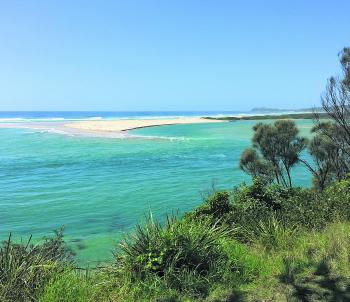
The entrance to the beautiful Tuross Lake doubles as a gorgeous sight and a great fishing spot.

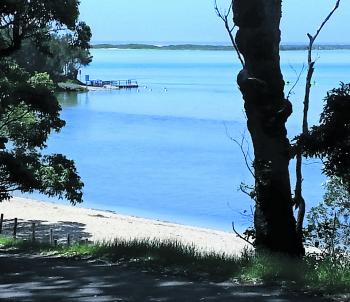
The main boat ramp at Lavender Bay is the most popular place to launch a boat.

My son with another nice flattie he caught from the drop-off.
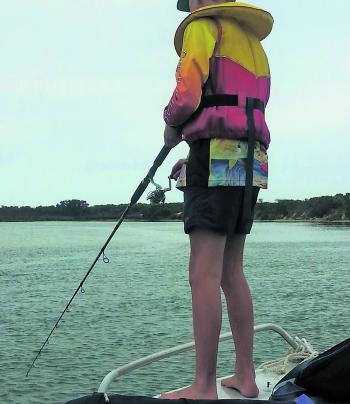
My son working the edge of a drop-off to catch flathead.
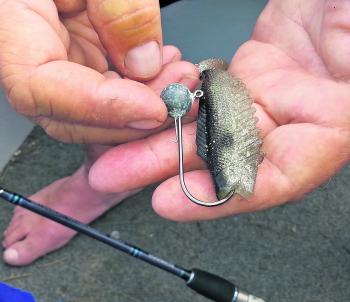
Scott Mazz showing how to fine-tune your lure for better results.
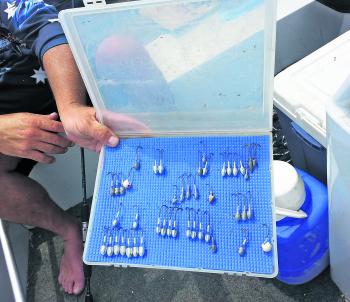
Fishing guides often have handy storage tips like this.
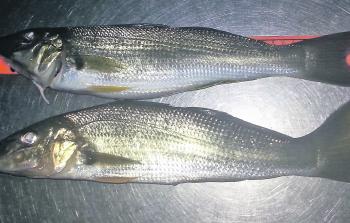
A couple of thumper whiting from Tuross caught at night.

This beach gutter produced a dozen big whiting on the rising tide.

Another monster Tuross whiting!




